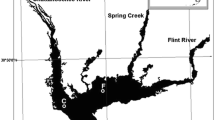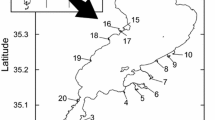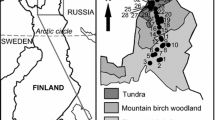Abstract
Residential development of lakeshores affects the structure and function of riparian and littoral habitats. Organic detritus in sediments is a critical component of littoral food webs, but the effects of urbanization on sediment characteristics are unexplored. We characterized the quantity of organic sediments in Pacific Northwest lakes along a development gradient and found a 10-fold decline in the proportion of detritus in littoral sediments associated with density of lakeshore dwellings. In a comparison between two fully developed lakes and two undeveloped reference lakes, we examined several possible controls on sedimentary organic content, including terrestrial inputs, decomposition rates and associated macroinvertebrate communities, and physical retention by coarse wood. The littoral sediments of undeveloped lakes ranged from 34 to 77% organic by mass, whereas the range on urban lakes was an order of magnitude less, ranging from 1 to 3% organic. We found no significant differences in terrestrial litter inputs between the two sets of lakes. Leaf litter decomposition rates did not vary significantly between the two sets of lakes, and we found higher densities of shredder macroinvertebrate taxa in the littoral zones of undeveloped lakes. Sedimentary organic matter on undeveloped lakes accumulated in shallow waters and declined with distance from shore, whereas the opposite pattern existed on urban lakes. Our results suggest that coarse wood physically retains organic matter in littoral zones where it can enter the detrital energy pathway, and the loss of this feature on urban lakes alters littoral sediment characteristics, with potentially far-reaching consequences for lake food webs.







Similar content being viewed by others
References
Bayo MM, Casas JJ, Cruz-Pizarro L. 2005. Decomposition of submerged Phragmites australis leaf litter in two highly eutrophic Mediterranean coastal lagoons: relative contribution of microbial respiration and macroinvertebrate feeding. Archiv fur Hydrobiologie 163:349–67
Bilby RE. 1981. Role of organic debris dams in regulating the export of dissolved and particulate matter from a forested watershed. Ecology 62:1234–43
Bilby RE, Ward J. 1991. Characteristics and function of large woody debris in streams draining old-growth, clear-cut, and 2nd-growth forests in southwestern Washington. Can J Fish Aquat Sci 48:2499–508
Binkley D, Sollins P, Bell R, Sachs D, Myrold D. 1992. Biogeochemistry of adjacent conifer and alder-conifer stands. Ecology 73:2022–33
Bisson PA, Bilby RE. 1998. Organic matter and trophic dynamics. In: Naiman RJ, Bilby RE, Eds. River ecology and management: lessons from the Pacific Coastal Ecoregion. Springer: New York. pp 373–98
Bjelke U, Herrmann J. 2005. Processing of two detritus types by lake-dwelling shredders: species-specific impacts and effects of species richness. J Anim Ecol 74:92–8
Bryan MD, Scarnecchia DL. 1992. Species richness, composition, and abundance of fish larvae and juveniles inhabiting natural and developed shorelines of a glacial Iowa lake. Environ Biol Fish 35:329–41
Carpenter SR, Caraco NF, Correll DL, Howarth RW, Sharpley AN, Smith VH. 1998. Nonpoint pollution of surface waters with phosphorus and nitrogen. Ecol Appl 8:559–68
Christensen DL, Herwig BR, Schindler DE, Carpenter SR. 1996. Impacts of lakeshore residential development on coarse woody debris in North Temperate lakes. Ecol Appl 6:1143–9
Cole JJ, Caraco NF, Kling GW, Kratz TK. 1994. Carbon dioxide supersaturation in the surface waters of lakes. Science 265:1568–70
Cole JJ, Pace ML, Carpenter SR, Kitchell JF. 2000. Persistence of net heterotrophy in lakes during nutrient addition and food web manipulations. Limnol Oceanogr 45:1718–30
Cole JJ, Carpenter SR, Pace ML, Van de Bogart MC, Hodgson JR. 2006. Differential support of lake food webs by three types of terrestrial organic carbon. Ecol Lett 9:558–68
Dodson SI, Lillie RA, Will-Wolf S. 2005. Land use, water chemistry, aquatic vegetation, and zooplankton community structure of shallow lakes. Ecol Appl 15:1191–8
Efford IE. 1969. Energy transfer in Marion Lake, British Columbia; with particular reference to fish feeding. Verh Int Ver Theor Angew Limnol 17:104–8
Elias JE, Meyer MW. 2003. Comparisons of undeveloped and developed shorelands, Northern Wisconsin, and recommendations for restoration. Wetlands 23:800–16
France RL, Peters RH. 1995. Predictive model of the effects on lake metabolism of decreased airborne litterfall through riparian deforestation. Conserv Biol 9:1578–86
Francis TB, Schindler DE. 2006. Degradation of littoral habitats by residential development: woody debris in lakes of the Pacific Northwest and Midwest, United States. Ambio 35:274–80
Franklin JF, Dyrness CT. 1973. Natural vegetation of Oregon and Washington. USDA Forest Service. Gen Tech Rep. p 417. Portland, Oregon
Gasith A, Hasler AD. 1976. Airborne litterfall as a source of organic matter in lakes. Limnol Oceanogr 21:253–8
Gude H, Teiber P, Rolinski S, Sala M. 2004. Comparison of production and degradation of organic matter at a littoral site of the prealpine Lake Constance. Limnologica 34:117–23
Hanson PC, Bade DL, Carpenter SR. 2003. Lake metabolism: relationships with dissolved organic carbon and phosphorus. Limnol Oceanogr 48:1112–9
Harmon ME, Franklin JF, Swanson FJ, Sollins P, Gregory SV, Lattin JD, Anderson NH, Cline SP, Aumen NG, Sedell JR, Lienkaember GW, Cromack K, Cummins KW. 1986. Ecology of coarse woody debris in temperate ecosystems. Adv Ecol Res 15:133–302
Hicks RE, Owen CJ, Aas P. 1994. Deposition, resuspension and decomposition of particulate organic matter in the sediments of Lake Itasca, Minnesota, USA. Hydrobiologia 284:79–91
James WF, Barko JW. 1990. Macrophyte influences on the zonation of sediment accretion and composition in a North-Temperate reservoir. Arch Hydrobiol 120:129–42
Jennings MJ, Emmons EE, Hatzenbeler GR, Edwards C, Bozek MA. 2003. Is littoral habitat affected by residential development and land use in watersheds of Wisconsin lakes? Lake Reserv Manage 19:272–9
Jordan M, Likens GE. 1975. An organic carbon budget for an oligotrophic lake in New Hampshire, USA. Verh Int Ver Theor Angew Limnol 19:994–1003
Kashian DR, Burton TM. 2000. A comparison of macroinvertebrates of two Great Lakes coastal wetlands: testing potential metrics for an index of ecological integrity. J Great Lakes Res 26:460–81
Lewin W-C, Okun N, Mehner T. 2004. Determinants of the distribution of juvenile fish in the littoral area of a shallow lake. Freshw Biol 49:410–24
Lindeman RL. 1942. The trophic-dynamic aspect of ecology. Ecology 23:399–417
Marburg AE, Turner MG, Kratz TK. 2006. Natural and anthropogenic variation in coarse wood among and within lakes. J Ecol 94:558–68
Moore JC, Berlow EL, Coleman DC, De Ruiter PC, Dong Q, Hastings A, Johnson NC, McCann K, Melville K, Morin PJ, Nadelhoffer K, Rosemond AD, Post DM, Sabo JL, Scow KM, Vanni MJ, Wall DH. 2004. Detritus, trophic dynamics and biodiversity. Ecol Lett 7:584–600
Moore JW, Schindler DE, Scheuerell MD, Smith D, Frodge J. 2003. Lake eutrophication at the urban fringe, Seattle region, USA. Ambio 32:13–8
Oertli B. 1993. Leaf litter processing and energy flow through macroinvertebrates in a woodland pond (Switzerland). Oecologia 96:466–77
Pace ML, Cole JJ, Carpenter SR, Kitchell JF, Hodgson JR, Van de Bogart MC, Bade DL, Kritzberg ES, Bastviken D. 2004. Whole-lake carbon-13 additions reveal terrestrial support of aquatic food webs. Nature 427:240–3
Petersen RC, Cummins KW. 1974. Leaf processing in a woodland stream. Freshw Biol 4:343–68
Pieczynska E. 1990a. Lentic aquatic-terrestrial ecotones: their structure, functions, and importance. In: Naiman RJ, Decamps H, Eds. The ecology and management of aquatic-terrestrial ecotones. Paris: United Nations Educational, Scientific and Cultural Organization. pp 103–40
Pieczynska E. 1990b. Littoral habitats and communities. In: Jorgensen SE, Loffler H, Eds. Guidelines of lake management, vol 3, Lake Shore Management. Shiga, Japan: International Lake Environment Committee. pp 39–71
Polis GA, Strong DR. 1996. Food web complexity and community dynamics. Am Nat 147:813–46
Quinlan R, Leavitt PR, Dixit AS, Hall RI, Smol JP. 2002. Landscape effects of climate, agriculture, and urbanization on benthic invertebrate communities of Canadian prairie lakes. Limnol Oceanogr 47:378–91
Rau GH. 1976. Dispersal of terrestrial plant litter into a subalpine lake. Oikos 27:153–60
Rowan JB, Kalff J, Rasmussen JB. 1992. Profundal sediment organic content and physical character do not reflect lake trophic status, but rather reflect inorganic sedimentation and exposure. Can J Fish Aquat Sci 49:1431–8
Saunders GW, Cummins KW, Gak DZ, Pieczynska E, Straskrabova V, Wetzel RG. 1980. Organic matter and decomposers. In: Le Cren ED, Lowe-McConnell RH, Eds. The functioning of freshwater ecosystems. Cambridge: Cambridge University Press. pp 341–92
Scheuerell MD, Schindler DE. 2004. Changes in the spatial distribution of fishes in lakes along a residential development gradient. Ecosystems 7:98–106
Schindler DE, Geib SI, Williams MR. 2000. Patterns of fish growth along a residential development gradient in north temperate lakes. Ecosystems 3:229–37
Schindler DE, Scheuerell MD. 2002. Habitat coupling in lake ecosystems. Oikos 98:177–89
Schindler DW. 1978. Factors regulating phytoplankton production and standing crop in the world’s freshwaters. Limnol Oceanogr 23:478–86
Szczepanski A. 1965. Deciduous leaves as a source of organic matter in lakes. Bull Acad Pol Sci 13:215–7
Vander Zanden MJ, Vadeboncoeur Y. 2002. Fishes as integrators of benthic and pelagic food webs in lakes. Ecology 83:2152–61
Webster JR, Benfield EF. 1986. Vascular plant breakdown in freshwater ecosystems. Ann Rev Ecol System 17:567–94
Wetzel RG. 1990. Land-water interfaces: metabolic and limnological regulators. Edgardo Baldi Memorial Lecture. Verh Int Ver Theor Angew Limnol 24:6–24
Woodford JE, Meyer MW. 2003. Impact of lakeshore development on green frog abundance. Biol Conserv 110:277–84
Acknowledgments
This work was supported by the National Science Foundation (IGERT-0114351) and the University of Washington’s College of Forest Resources. We thank the staff of the UBC Malcolm Knapp Research Forest for their logistical assistance and access to Loon and Gwendoline Lakes. We are also grateful to the residents of Star and Shady Lakes for their assistance and patience. Matt Baker, P. Dee Boersma, Gordon Holtgrieve, John Marzluff, and Mark Scheuerell provided helpful comments on earlier drafts of the article.
Author information
Authors and Affiliations
Corresponding author
Rights and permissions
About this article
Cite this article
Francis, T.B., Schindler, D.E., Fox, J.M. et al. Effects of Urbanization on the Dynamics of Organic Sediments in Temperate Lakes. Ecosystems 10, 1057–1068 (2007). https://doi.org/10.1007/s10021-007-9077-0
Received:
Revised:
Accepted:
Published:
Issue Date:
DOI: https://doi.org/10.1007/s10021-007-9077-0




